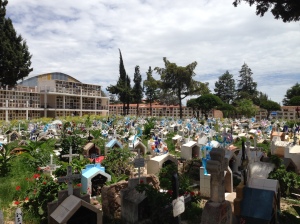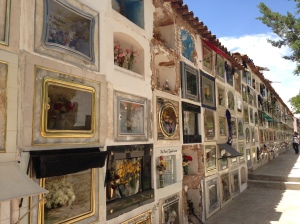Sucre Tips and Tricks (you may not get from your travel guide)
My favorite local attraction: Go see the cemetery. It sounds a little morbid, but I will truly put this at the top of my to-see-in-Sucre list because it is so much more than a cemetery – it is another tribute to Sucre’s robust history. More of a large park with plenty of benches on which to sit and reflect or take in the scenery, the cemetery is filled with grandeur. From crypts and mausoleums, Princes to past presidents, tributes to fallen soldiers killed in the various wars of the modern days, it’s yet another place to learn a concise but in-depth version of Sucre’s history. There is even a small plot for Jewish citizens with names like Else Schiller and Edith Kassewitz. For 20 bolivianos (about $3 USD), a well versed high school student will take you through the historic first garden of the cemetery, imparting an incredible amount of knowledge to anybody curious to learn more about the cemetery. The tour is in Spanish, but if you speak even just a little or are able to recruit someone to translate, it’s well worth your time and money. Recurring theme here again is Sucre’s war to remain the capital. In 1899 the civil war between Sucre and La Paz stripped this city of 2 branches of government, but the people will never give up the struggle to remain the figurehead of their country. One memorial depicts the Virgin Mary, holding an olive wreath as a peace offering for the fallen, all university students who ventured to La Paz to protest the city’s claim to the capital.  The story goes that they managed to escape the city, but the campesinos (in the country), captured them, decapitated them, and drank the blood from their heads…. A characteristically gory and morbid story, but every 24th of January, a crowd gathers around the memorial to pay homage to the students and remember, always that they died defending their city’s name and history.
The story goes that they managed to escape the city, but the campesinos (in the country), captured them, decapitated them, and drank the blood from their heads…. A characteristically gory and morbid story, but every 24th of January, a crowd gathers around the memorial to pay homage to the students and remember, always that they died defending their city’s name and history.
Other interesting thing about the cemetery – grave plots are for the most part, rented. Not just rented, but leased for 3 years, with the option to renew once for 3 more years, then the remains are removed and cremated (if the family desires). At this point, the ashes can be moved to a different location in the cemetery, for up to 4 years. Then that’s it! Out with the old, in with the new. Without any more space, and with many more people, this is how the system functions.
 I was struck by many things about the cemetery, namely the care that goes into each graves site, as well as how well kept the grounds are. It seems strange to say, but it was so inundated with history and the peace of death, I felt like I could go there any day just to clear my mind. I was also struck by the size of the section for children, from infants to pre-teens. My Spanish teacher told me that many die in accidents or from illnesses. The graves of the wealthy, middle class, and poor are also very distinct – the poorest are crowded into the ground, the middle class occupy stacked rows of above ground tombs, and the wealthy have built shrines – mausoleums for generations of their family to come.
I was struck by many things about the cemetery, namely the care that goes into each graves site, as well as how well kept the grounds are. It seems strange to say, but it was so inundated with history and the peace of death, I felt like I could go there any day just to clear my mind. I was also struck by the size of the section for children, from infants to pre-teens. My Spanish teacher told me that many die in accidents or from illnesses. The graves of the wealthy, middle class, and poor are also very distinct – the poorest are crowded into the ground, the middle class occupy stacked rows of above ground tombs, and the wealthy have built shrines – mausoleums for generations of their family to come.
My point – tour or no tour, the cemetery should be high on your list of places to see in Sucre.
An important rule when travelling in general: Don’t underestimate word of mouth. Guide books are a good place to start, but being open to meeting people (both local and travelers) has led me to far more interesting places and people than my Lonely Planet guide.
Transportation: A taxi ride within town during the day is 4 boliviano/person, it goes up to 5 BS after 9 PM. Exact change is best to avoid being over charged, and don’t ask or negotiate unless it is a distant destination, just pay your 4. Busses are available to many parts of the country and are extremely cheap, just be aware it might be long and uncomfortable. Depending on your destination and budget, it might be worth it to fly with one of the several cheap, domestic airlines.
• Fly Amaszonas or EcoJet within Bolivia, but buy your ticket in the office. Not only is it lovely to be helped by a human being, but it also happens to be cheaper than purchasing online
• Fly BOA for Bolivia – Argentina. 1 flight/day from Santa Cruz to Buenos Aires, and again, go to the office. My ticket purchased in-person was 1/3 the price quoted to me online.
Language classes:
Continental Spanish School – I took “Private” lessons for $6/hour, 4 hours per day for about 2 ½ weeks and truly could not believe how far my language skills came. I still have a long way to go, but Maria Elena is a stickler for grammar and forces you to correct your mistakes. They use practical activities for application of grammatical lessons.
Lodging – I stayed with a family for $13 USD/day, 3 meals included, through my Spanish school, but I heard from many people that Casa Verde B&B is a lovely (slightly more expensive) option with a stellar breakfast included. The Beehive Hostel is supposed to be a great hostelling option and nice community to join for a while. For the most part I loved my homestay – it was a wonderful way to learn the culture and history of Sucre from the people who know it best, and to be made a part of a family far from home. My only cautions would be that depending on the family, being independent in day-to-day activities can be more challenging, and that the diet of Sucre is heavy in meat, potatoes, and bread (not always fresh), so plan to obtain some of your own fruits and veggies if you do a homestay.
Volunteering – While the main part of town seems solidly in the middle class, Sucre is steeped in the same poverty that plagues much of the country and volunteer opportunities abound. My Dutch friend with no end to her energy, volunteered at the hospital in the pediatric long-term-care/rehab unit 4 hours/day, 5 -6 days per week, in addition to the 20 hours/week of Spanish lessons she was doing. She loved it, and was of course very popular with the children.
Final thoughts: I loved Sucre. It’s a great place to hang your hat for a while; full of cheap eats, nice people, and a rich culture and history. Don’t leave it out! I will be forever happy that I started my journey there, and grateful to the people who made it so special. And I will definitely be back.



